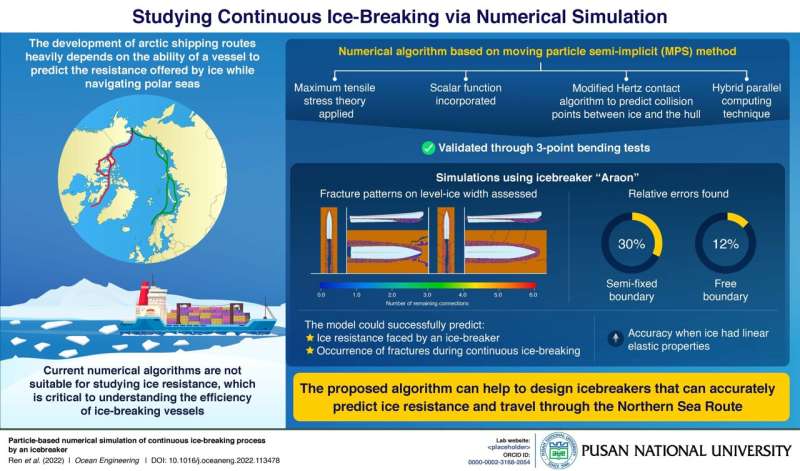Researchers from Pusan National University in Korea have developed a numerical simulation to predict the continuous ice-breaking capacity of an icebreaker navigating polar seas. The study can be used for the efficient design of icebreakers that can travel the Northern Arctic route, help improve trade, and distribute resources. Credit: Jong-Chun Park from Pusan National University, Korea
Global warming has put a significant strain on resources, and hence, economic opportunities, military considerations, and trade. The development of Arctic shipping routes is necessary to compensate for these changes, and so, has garnered much interest recently. One of the fundamental requirements of a vessel navigating the polar seas is its ability to predict ice resistance.
Many researchers have used numerical algorithms to study the ice-breaking capacity of icebreakers—i.e., ships capable of breaking through the ice. However, most of these algorithms cannot be used to study the continuous ice-breaking process, and no general ice fracture criterion exists for different environments.
Set against this backdrop, a duo of researchers from Pusan National University (PNU), Korea, have now developed a numerical algorithm using an elastic model based on the moving particle semi-implicit (MPS) method. The study, which was led by Prof. Jong-Chun Park from PNU, was published in Ocean Engineering. Prof. Park, explains the starting point of their study: "We assumed ice to be a linear elastic material prior to fracture, and applied the maximum tensile stress theory as the criteria for fracture."
The MPS method is a particle method based on continuum mechanics, which is ideal for studying the continuous ice-breaking process including the development of a crack-like phenomenon. In addition, a scalar function was introduced to represent the relative position of a new ice crack with respect to the particles adjacent to it, and a search algorithm was used to predict the collision points between the ice and the hull. A hybrid parallel computing technique was introduced to manage the large-scale computations involved.
The model was tested using three-point bending tests on freshwater and model ice specimens. These revealed an increase in the accuracy of the model when the properties of the ice were close to the linear elastic properties chosen for the model. Then, simulations were performed using a model icebreaker called Araon. These simulations showed relative errors of 12% for free boundary conditions and 30% for semi-fixed boundary conditions in level-ice environments.
"The model can successfully predict the ice resistance faced by an icebreaker, as well as the occurrence of fractures during continuous ice-breaking. This can be used to design icebreakers that can travel through the Northern Sea Route, where they often encounter ice. Developing this shipping route will help trade and also ensure an improved distribution of resources," concludes Prof. Park.
More information: Di Ren et al, Particle-based numerical simulation of continuous ice-breaking process by an icebreaker, Ocean Engineering (2023). DOI: 10.1016/j.oceaneng.2022.113478
Provided by Pusan National University
























